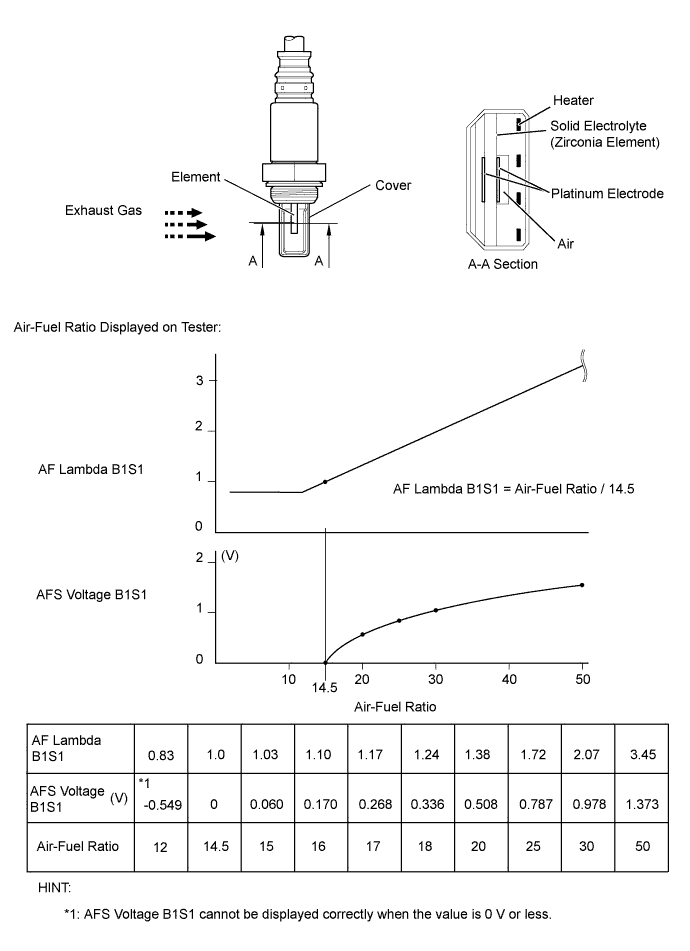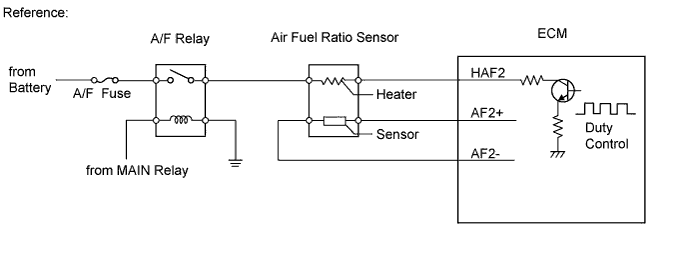CHECK HARNESS AND CONNECTOR (AIR FUEL RATIO SENSOR - ECM)
CONFIRM WHETHER MALFUNCTION HAS BEEN SUCCESSFULLY REPAIRED
REPAIR OR REPLACE HARNESS OR CONNECTOR
CONFIRM WHETHER MALFUNCTION HAS BEEN SUCCESSFULLY REPAIRED
DTC P2237 Oxygen (A/F) Sensor Pumping Current Circuit / Open (Bank 1 Sensor 1) |
DTC P2238 Oxygen (A/F) Sensor Pumping Current Circuit Low (Bank 1 Sensor 1) |
DTC P2239 Oxygen (A/F) Sensor Pumping Current Circuit High (Bank 1 Sensor 1) |
DTC P2252 Oxygen (A/F) Sensor Reference Ground Circuit Low (Bank 1 Sensor 1) |
DTC P2253 Oxygen (A/F) Sensor Reference Ground Circuit High (Bank 1 Sensor 1) |
DESCRIPTION
- HINT:
- For more information on the air fuel ratio sensor and Diesel Particulate Filter (DPF), refer to the following procedures (HILUX_TGN26 RM000000XSN02CX.html).
- If P2237, P2238 and/or P2239 is present, refer to the DTC table for DPF system (HILUX_TGN26 RM000000XSN02CX.html).
- These DTCs are recorded when the air fuel ratio sensor has a malfunction, although the title is the oxygen sensor.
The air fuel ratio sensor is located after the DPF catalytic converter. This sensor has been developed based on the structure and technology of a sensor that is being used for gasoline engines. The cover portion of the sensor has been changed for use in the diesel engine with DPF in order to eliminate the influence of the sensor temperature and particulate matter (PM).
In order to reduce both PM, the ECM adjusts the air-fuel ratio to slightly rich (but it is lean compared with the stoichiometric air-fuel ratio) based on signals from the air fuel ratio sensor. When the ECM performs PM forced regeneration using adding fuel using the exhaust fuel addition injector, the air-fuel ratio is also properly adjusted using the sensor.
*: The voltage value changes inside the ECM only.

- HINT:
- The ECM provides a pulse width modulated control circuit to adjust current through the heater. The air fuel ratio sensor heater circuit uses a relay on the B+ side of the circuit.

| DTC Detection Drive Pattern | DTC Detection Condition | Trouble Area |
| When either of the following conditions is met (1 trip detection logic):
| Main trouble area: Open in air fuel ratio sensor circuit
|
| DTC Detection Drive Pattern | DTC Detection Condition | Trouble Area |
| Ignition switch ON for 7 seconds | Air fuel ratio sensor circuit low (bank 1 sensor 1) (1 trip detection logic) | Main trouble area: Open in air fuel ratio sensor circuit
|
| DTC Detection Drive Pattern | DTC Detection Condition | Trouble Area |
| Ignition switch ON for 7 seconds | Air fuel ratio sensor circuit high (bank 1 sensor 1) (1 trip detection logic) | Main trouble area: Short in air fuel ratio sensor circuit
|
| DTC Detection Drive Pattern | DTC Detection Condition | Trouble Area |
| Ignition switch ON for 7 seconds | Air fuel ratio sensor circuit low (bank 1 sensor 1) (1 trip detection logic) | Main trouble area: Open in air fuel ratio sensor circuit
|
| DTC Detection Drive Pattern | DTC Detection Condition | Trouble Area |
| Ignition switch ON for 7 seconds | Air fuel ratio sensor circuit high (bank 1 sensor 1) (1 trip detection logic) | Main trouble area: Short in air fuel ratio sensor circuit
|
| DTC No. | Data List |
| P2237 |
|
| P2238 | |
| P2239 | |
| P2252 | |
| P2253 |
MONITOR DESCRIPTION
The air fuel ratio sensor outputs a voltage in proportion to the air-fuel ratio. If impedance (alternating current resistance) or voltage output of the sensor deviates greatly from the standard range, the ECM interprets this as an open or short malfunction of the air fuel ratio sensor circuit.WIRING DIAGRAM
Refer to DTC P0031 (HILUX_TGN26 RM00000187I02XX_03.html).INSPECTION PROCEDURE
- NOTICE:
- Inspect the fuses of circuits related to this system before performing the following inspection procedure.
- After replacing the ECM, the new ECM needs registration (HILUX_TGN26 RM0000012XK070X.html) and initialization (HILUX_TGN26 RM000000TIN057X.html).
- After replacing the fuel supply pump assembly, the ECM needs initialization (HILUX_TGN26 RM000000TIN057X.html).
- After replacing an injector assembly, the ECM needs registration (HILUX_TGN26 RM0000012XK070X.html).
- HINT:
- Read freeze frame data using the intelligent tester. Freeze frame data records the engine condition when malfunctions are detected. When troubleshooting, freeze frame data can help determine if the vehicle was moving or stationary, if the engine was warmed up or not, and other data from the time the malfunction occurred.
| 1.CHECK HARNESS AND CONNECTOR (AIR FUEL RATIO SENSOR - ECM) |
Disconnect the air fuel ratio sensor connector.
Disconnect the ECM connector.
Measure the resistance according to the value(s) in the table below.
- Standard Resistance:
Tester Connection Condition Specified Condition C124-3 (AF2+) - C111-2 (AF2+) Always Below 1 Ω C124-4 (AF2-) - C111-1 (AF2-) Always Below 1 Ω C124-3 (AF2+) or C111-2 (AF2+) - Body ground Always 10 kΩ or higher C124-4 (AF2-) or C111-1 (AF2-) - Body ground Always 10 kΩ or higher
Reconnect the air fuel ratio sensor connector.
Reconnect the ECM connector.
|
| ||||
| OK | |
| 2.REPLACE AIR FUEL RATIO SENSOR |
Replace the air fuel ratio sensor (HILUX_TGN26 RM000004KGB00BX.html).
| NEXT | |
| 3.CONFIRM WHETHER MALFUNCTION HAS BEEN SUCCESSFULLY REPAIRED |
Warm up the engine.
Connect the intelligent tester to the DLC3.
Turn the ignition switch to ON.
Turn the tester on.
Clear the DTCs (HILUX_TGN26 RM000000PDK11ZX.html).
Drive the vehicle at 50 km/h (30 mph) or more for a total of 300 seconds or more.
- HINT:
- Make sure that the exhaust gas temperature (Exhaust Temperature B1S1) is 200°C (392°F) or higher.
Confirm that the DTC is not output again.
|
| ||||
| OK | ||
| ||
| 4.REPLACE ECM |
Replace the ECM (HILUX_TGN26 RM0000013Z001HX.html).
|
| ||||
| 5.REPAIR OR REPLACE HARNESS OR CONNECTOR |
Repair or replace the harness or connector.
| NEXT | |
| 6.CONFIRM WHETHER MALFUNCTION HAS BEEN SUCCESSFULLY REPAIRED |
Warm up the engine.
Connect the intelligent tester to the DLC3.
Turn the ignition switch to ON.
Turn the tester on.
Clear the DTCs (HILUX_TGN26 RM000000PDK11ZX.html).
Drive the vehicle at 50 km/h (30 mph) or more for a total of 300 seconds or more.
- HINT:
- Make sure that the exhaust gas temperature (Exhaust Temperature B1S1) is 200°C (392°F) or higher.
Confirm that the DTC is not output again.
| NEXT | ||
| ||